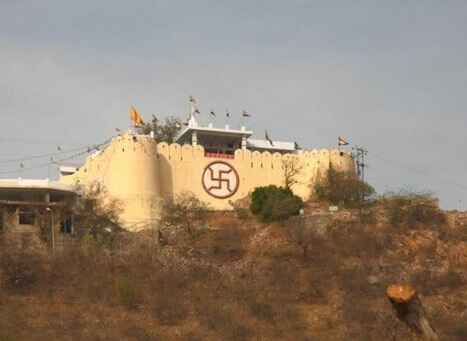Perched atop the Aravalli Hills near the historic Nahargarh Fort, Garh Ganesh Temple is one of Jaipur’s most revered and spiritually significant temples. Dedicated to Lord Ganesha, the remover of obstacles and the god of beginnings, this ancient shrine is known not just for its religious importance but also for its scenic location and panoramic views of the Pink City.
Historical Significance
Garh Ganesh Temple was built by Maharaja Sawai Jai Singh II, the founder of Jaipur, in the early 18th century. It is believed that the temple was constructed even before the city of Jaipur was formally established. The Maharaja performed the “Ashwamedha Yagna” at this location and installed the idol of Lord Ganesha here to protect the newly forming city. The temple was strategically placed on a hill so that the deity could keep a watchful eye over Jaipur.
What makes this temple unique is the form of Lord Ganesha worshipped here. Unlike most temples where Ganesha is depicted with a trunk and his familiar chubby form, Garh Ganesh houses a statue of Ganesha as a small child—called Vigra Purushakriti, with a human head rather than the traditional elephant head. This form is rarely seen and holds special spiritual value.
Architecture and Layout
The temple follows traditional Rajput architecture with a touch of simplicity. It features intricately carved pillars, domed ceilings, and a sanctum sanctorum that houses the unique idol. Reaching the temple involves a steep climb of around 365 steps, symbolizing the number of days in a year, which is often seen as a form of spiritual devotion and penance by devotees.
From the temple premises, one can enjoy breathtaking views of Jaipur, including the City Palace, Jal Mahal, and the Nahargarh Fort. The serene atmosphere at the top offers a peaceful retreat from the hustle and bustle of city life.
Religious Importance and Festivals
Garh Ganesh Temple holds immense religious significance, especially during Ganesh Chaturthi, when thousands of devotees flock here to seek blessings. The temple also hosts annual fairs and processions, particularly during the five-day Ganesh festival, drawing pilgrims from across Rajasthan.
On every Wednesday, which is considered auspicious for Lord Ganesha, special prayers and rituals are held, and the temple remains crowded with local devotees.
Visiting Tips
- Best Time to Visit: Early morning or late evening for a comfortable climb and to enjoy the sunrise or sunset views.
- Footwear: Must be removed before entering the temple.
- Photography: Allowed outside but restricted inside the sanctum.
- Accessibility: The climb may be challenging for elderly or physically unfit individuals; there is no elevator or ropeway service.
